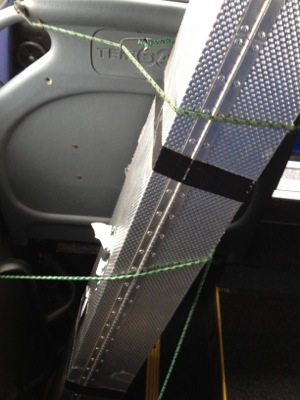August 2, 2012
by Kathryn Catlin
0 comments
Today was my last day of fieldwork in Iceland for 2012! (Don’t worry, everyone else is staying for a few more days, and they’ll keep blogging.) I’m sorry to leave just when so many exciting things are coming in to view at Seyla – a few more grave cuts are exposed, and the church in the center of the yard is beginning to take shape.
Over the weekend we traveled to Kumlabrekka, an early Viking Age boat burial on the side of a pseudocrater, to test the CMD and GPR through volcanic scoria. The Mývatn region is one of the most beautiful in Iceland. But Mývatn means “midge lake,” and when the wind dies down, the midges come out! They are everywhere and they bite.

Brian surveying with the CMD at Mývatn while Doug takes GPS points. You can’t see Doug’s face, because it is covered with mosquito netting.
The survey went great – which I’m especially happy about, because I carried the CMD for most of it!
This afternoon I spent some time showing Guðmundur, an archaeologist who works at the museum here in Sauðarkrókur, how to work our float machine so he can process macrobotanical samples after we leave. We decorated the Minja Husið sign with beautiful pink and blue chiffon!

Floating beside the museum. The chiffon bags catch the botanicals as they float over the top of the machine, and then we air dry them before inspecting them under a microscope. Tiny preserved seeds tell us which plants may have been used by the people who lived at Stóra-Seyla in the 11th century.

The float tank in action! The freshly painted tank (just the white parts are fresh) was designed by John and constructed by a local welder in SASS’s early days. You can also see the magnificent swamp we’ve created beside the museum …
Early tomorrow morning I leave for England, where I’ll be doing some survey work with Matthew Johnson’s project at Bodiam and Scotney Castles. Then I’m moving from Boston to Chicago to start my first quarter as a PhD student at Northwestern University. I’m very excited about all of this, but sad to leave Iceland (and UMass) behind. I hope to be back in Skagafjörður next summer!
Stay tuned to this blog for more about the last week of excavation at Seyla!
 We have lost a great friend. Grétar Guðbergsson passed away last week at the age of 78. Grétar, who called himself an agricultural geologist, set the stage for our archaeological work in Skagafjörður by understanding the nature of the erosion and soil deposition. His findings were published in three important works:
We have lost a great friend. Grétar Guðbergsson passed away last week at the age of 78. Grétar, who called himself an agricultural geologist, set the stage for our archaeological work in Skagafjörður by understanding the nature of the erosion and soil deposition. His findings were published in three important works:













